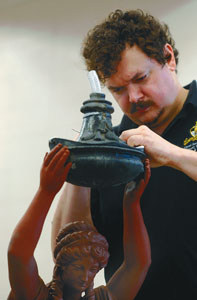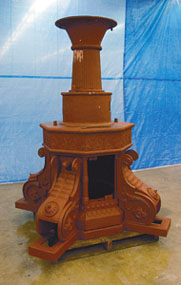| |
|
Putting the pieces
BACK TOGETHER: Conservator restores Anderson
Fountain
 |
 |
|
| Ted Monnich works on
patching part of the General Robert Anderson
Fountain with resin at the Hanna Westside
Extension Campus. The final fountain will stand
18 feet tall and be a glossy black. [Sarah Bates Anderson
Independent-Mail] |
|
 |
|
| This cast iron pedestal
to the Robert Anderson fountain was orginally
cast in Columbia and brought to Anderson when it
was built. [Sarah Bates
Anderson
Independent-Mail] |
| | By Nicholas
Charalambous
Anderson
Independent-Mail
9/29/2002
The first time Ted
Monnich saw the Gen. Robert Anderson Fountain, he
couldn't believe his eyes.
The restoration
specialist had been told by county officials that the
fountain was in "storage," so he was confused as he and
county museum director Paula Reel walked along a muddy
trail at the White Street dump. Then he saw it. The
once-gleaming tribute to civic pride was strewn in
dozens of pieces across the ground behind a shed, caked
in grime.
Nearly two years after the group Save
Outdoor Sculpture brought Mr. Monnich to Anderson to see
if the fountain could be saved, the conservator was in a
temporary workshop at the Hanna-Westside Extension
campus last week showing off five weeks of his handy
work.
The fountain was now in three large pieces,
ready to be painted with black enamel and then assembled
outside the rear courtyard to the new Anderson County
museum on Greenville Street.
"It's come a long
way," said Mr. Monnich, who until this summer was chief
conservator at the state museum in Columbia.
Mr.
Monnich, 41, had spent 20 years restoring some of the
"finest of the finest" of metal objects in the world. As
the one-time conservator with the Metropolitan Museum of
Art in New York, he had worked on a suit of armor once
owned by England's King Henry VIII as well as a Rodin's
sculpture called The Shade.
When he accepted the
assignment in Anderson, he said he didn't know much
about the 96-year-old fountain's history as a gift from
the Anderson Civic League or its claim to fame as the
first fountain in North America with underwater
lighting.
"I don't need that to get me excited
about a piece," he said. "Whether its working on an old
bed pan from a state hospital or the Mona Lisa, the
pieces get the same treatment."
Mr. Monnich said
he was attracted to the project from a restoration
viewpoint because of its size and scope.
The restoration of the Gen. Robert Anderson
Memorial Fountain took about five weeks. Here are
the steps that conservator Ted Monnich
took:
Cataloging: Gather and log
each remnant of the fountain that survived its
dismantling to determine what parts were missing.
Include a precise description of each piece to aid
putting parts back together. 3
days.
Cleaning: Use soft brushes
with a PH neutral solution, neither acidic nor
alkaline, to loosen and dissolve dirt and grime.
Use a pressure washer to remove stubborn dirt. 3
days
Restoring: Use wire brushes to
remove heavy corrosion and old flaking paint.
Treat with a polymer mixed with a tannic acid
solution, similar to a rust convertor available at
home improvement stores, to convert rust into a
stable iron oxide. 2 weeks
Rebuilding:
Remove any extraneous modifications or
additions to the fountain made over its lifetime.
Use epoxy resin to fill in holes or rust spots and
reconstruct small areas that are damaged or
missing. 1 week
Refinishing: Add two
coats of industrial primer as a base and follow
with industrial black enamel gloss paint. 3
days.
Reassembling: Bolt or weld
smaller parts of the fountain back together. Add
new electric pump and piping. Transport larger
parts to future fountain location, and use cranes,
forklifts and other heavy equipment to put it in
place. | The fountain,
which altogether weighed more than 1,200 pounds and
stood 18 feet tall when assembled, had to be pieced
together from a jagged jumble of parts which was the
result of it being "hacked up" and removed from behind
the historic courthouse in the early 1990s, he
said.
"It was not taken apart with the intention
of being put back together again," he said. "While
you're working on it, you're thinking, ‘Why did they do
this?'"
In a corner of the workshop, there is
still a small pile of bolts, pipe and decorative wrought
iron pieces that he originally thought belonged to the
historic structure.
Surprisingly, only two pieces
were missing: a plaque on the fountain's four-sided
pedestal commemorating its construction and one of the
cherubs that stood atop the large bowl. Mr. Monnich said
a new plaque will be added to commemorate its
restoration. He's still seeking a replica of the
cherub.
Working with two other colleagues, Mr.
Monnich spent most of his time cleaning the metal
pieces, treating them for corrosion, filling in odd bolt
holes and rust holes with resin, welding broken pieces
and finally bolting the different sections of the
fountain together.
But Mr. Monnich also had some
some delicate work. Using a putty-like resin and a piece
of wire, he hand-sculpted a new thumb to replace one
that had broken off the female figure that stands at the
top of the fountain.
He also had to rebuild part
of her skirt, forming and molding the same resin into a
flowing fold that was barely indistinguishable from
those rippling next to it.
"We don't want it to
look like a different fountain," Mr. Monnich said. "We
want it to be what it was."
Fittingly, the
rebirth of the fountain also represented a renaissance
of the community spirit that led to its original
construction. The restoration was paid for by hundreds
of readers of the Anderson Independent-Mail who
donated $45,000.
The outpouring of affection
seemed to be a collective mea culpa for the community's
past neglect.
The community kept up its interest
by visiting the workshop three days a week for a chance
to see Mr. Monnich at work.
"I think they
appreciated it. They enjoyed being able to see the
process and to learn about the work that Ted does," said
Catherine Bergstrom, museum curator.
Ms.
Bergstrom said she expected the fountain to be assembled
on site within a few weeks. A grand unveiling will then
occur, where the honored guests will be those who
donated money for its restoration.
The rise, fall
and rise of a treasured artifact is a cycle conservators
celebrate. For Mr. Monnich, it's also humbling reminder
of art's false permanence together with a tantalizing
hope that it can cheat time.
"All of these
objects will turn to dust one day," he said. "My job is
to slow it down."
|
home services
projects clients
philosophy history
|
|
 |
|
Anderson
Independent-Mail
PO Box 2507, Anderson, SC
29622
(800) 859-6397
©2002 Independent Publishing
Company, a division of E.W.
Scripps
All rights reserved. Please view the user
agreement and privacy
policy.
Send comments to online@andersonsc.com
(This
website is optimized for viewing in Internet Explorer 5.5 and
later.)
| |
|
|
| |